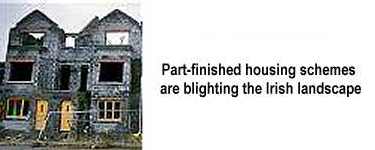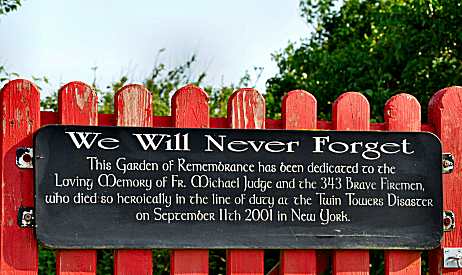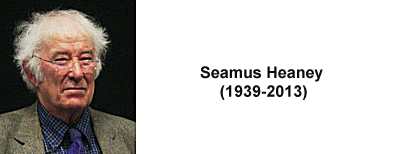| HELP TO KEEP THIS NEWSLETTER ALIVE! | |
|
NEED A WEDDING, ANNIVERSARY OR BIRTHDAY GIFT? Shop Online at https://www.irishnation.com |
|

Marvellous Family Crest Shields |

Display your Heritage: Family Crest Flags |

Glistening Galway Crystal |

Stunning Irish Rings |
| More Gift Ideas From Ireland | |

===========
IN THIS ISSUE
===========
=== News Snaps from Ireland
=== Galway City Museum
=== The Giant's Causeway, County Antrim
=== My Home - a Poem by Kevin Joseph Molloy
=== The Garden of Remembrance in Kinsale by Carol Boyne Martin
=== Nothing Stays (for Seamus Heaney, 1939-2013) by Kath Fearing
=== YouTube Videos of Irish Interest
=== Gaelic Phrases of the Month
=== Monthly Free Competition Result
Popular Articles from Recent Newsletters:
The Huguenots in Ireland
Powerscourt House and Gardens, County Wicklow
Newgrange, County Meath
==========
FOREWORD
==========
|
Many thanks to our readers contributions this month. We have 2 poems and a visitors tale of her experience to a 9/11 memorial site in Ireland. Maybe You have a story or article you would like to share?
The next newsletter will issue in advance of Halloween so be sure to keep an eye out for it! Until next time, Michael |

PLEASE 'LIKE US' ON FACEBOOK!
P.S. Please DO FORWARD this Newsletter to a
friend or relative. If you have a website or Facebook
page or Blog (or whatever!) then you can help
us out by putting a link on it to our website:
www.ireland-information.com
Do tell your friends about us as this helps
to keep this newsletter free!
SEND US YOUR PHOTOS OF IRELAND
Got any decent holiday snaps of Ireland - we want them!!
The Information about Ireland Site is compiling a
Free Photographs of Ireland Library and specifically all
of the towns and tourist sites of the country. Photos of
any castle, lake, river, mountain, building, town,
landscape, tourist attraction or historic site are sought.

These photos will be made freely available for anyone
to use in their blogs, school reports, articles,
websites, Facebook pages or projects.
Please contact us from here: https://www.irishnation.com/cgi-bin/contactfront.cgi
and we will send you further information. All contributors
will be entered (and re-entered every month) into a monthly
draw for a family crest print for the name of their choosing.
WE NEED YOUR HELP - CONTRIBUTE!
Got something to say? Don't keep it to yourself!
Why don't you submit an article for inclusion
in the next edition? Go here for more information:
https://www.ireland-information.com/newsletter.htm
Do you have access to a website? You can help to
keep this newsletter alive by adding a link to
any of our websites below:
https://www.irishnation.com
http://www.irishsurnames.com
https://www.ireland-information.com
http://www.allfamilycrests.com
http://www.irishpenpals.com
If you have an AOL or HOTMAIL account then you
may get better results by viewing this
newsletter online here:
https://www.ireland-information.com/sep13.htm
The only way that you could have been
subscribed to this newsletter is by filling
out a subscription form at the site whereupon
a confirmation notice would have been issued.
If you wish to unsubscribe then go here:
https://www.ireland-information.com/newsletter.htm
========================
NEWS SNAPS FROM IRELAND
========================
|
RECENT OPINION POLL IS GREAT NEWS FOR SINN FEIN A recent Irish Times/Ipsos MRBI opinion poll makes for very grim reading for the Labour Party but is great news for Sinn Fein. 
Labour are in Government with Fine Gael whom they joined in coalition after the 2011 General Election. Fine Gael took the bulk of the Fianna Fail vote with Labour also soaring to new highs in the hope that the party would see off the money-men of the EU/IMF/ECB troika who were hated by large sections of the Irish population. 'Burn the bondholders' 'Let the banks fail', 'Gilmore for Taoiseach' were the rallying cries. The reality has been very different. Nurses, Labourers, Teachers, Public and Civil Servants, lower-paid workers and even the unemployed all voted for Labour in their droves at the last election. Now they are looking elsewhere. 
By continuing the policies of the previous Fianna Fail government both Labour and Fine Gael chose to play a long game. Fine Gael could make the case that they have no choice but to implement the policies they inherited while alternately blaming Fianna Fail and then claiming the credit for the economy stabilizing. Labour however, have no such luxury. It was the Labour Party that was supposed to represent the working classes. Instead they implemented cuts to services and installed the hated Property Tax, threatening and bullying the Irish citizenry into submission. 
Just 6% of voters now say they would now vote for Labour (down from 19%) while 23% say they would vote for Sinn Fein and 22% for Fianna Fail. Sinn Fein and the Labour Party occupy much of the same left-wing space on the political spectrum yet it is Gerry Adam's party that now seems to represent the working classes. With 26% support Fine Gael cannot afford to be too smug either. Both they and Fianna Fail have repeatedly said that they would not go into a coalition Government with Sinn Fein. Logically then, if an election were held tomorrow the obvious new Government would be a coalition of Fine Gael and Fianna Fail! In the US this would be the equivalent of Mitt Romney cozying up with Barack Obama in a Democrat-Republican national government to run the country. Could it happen in Ireland? This possibility has recently been floated by former members of both of these political parties. Fianna Fail and Fine Gael have their genesis in the 1922 Irish Civil War. Over the last two decades any lingering differences have rapidly dissipated. Socially Fine Gael is viewed as being more conservative than Fianna Fail but there seems to be little to choose between their economic approach. Is a grand union possible? In Ireland after the economic crash, anything is possible. DUBLIN PROPERTY MARKET INCREASE SPARKS FEAR OF A NEW BUBBLE The Irish people do not need any reminding of the devastating effect that a property bubble can have. Back in 2008 when the property market in Ireland imploded the Irish banks had to go cap-in-hand to the Government for support. 'Back us or the ATMs will stop working' was the blunt message offered to the Irish politicians of the time. They duly obliged by underwriting the deposits held by the banks, preventing any mass withdrawal of funds by the public and financial institutions. 
The problem with the bank guarantee was that, while it kept the ATMs operating it also underwrote the funds held by the massive institutional investors, including those in France and Germany. When the banks were eventually nationalized the bonds held by the European investors became payable by the Irish State. 'Burn the Bondholders' was one of the famous slogans used in the run up to the 2011 election. To date there has been little or no evidence of that happening with the EU/IMF/ECB troika protecting their own interests while drip-feeding enough finance into the Irish economy to keep the lights on. The situation has stabilized since then but at some cost. Unemployment remains stubbornly above 14%. Job opportunities are limited with massive emigration the escape valve. Taxation has been greatly increased to the point where even those most enthusiastic in engaging austerity are suggesting that a financial stimulus and not more taxation is now what is required. Against this backdrop the Irish property market has suffered one of the greatest collapses in modern history. Only Dubai has suffered a bigger recent loss as the value of houses and apartments plummeted by anywhere between 40% and 60% depending on the report that is cited. Banks of course, are now much more stringent in their lending policies, anxious to avoid the mistakes of the past. But it may be a case of 'a short memory' for some people. It has long been suspected that the value of houses in Dublin has dropped too much, with no such reservations about the price falls in rural locations. Tiny little towns with half-built housing estates and a dwindling population are a recipe for further house price falls. But in Dublin there are enclaves and districts that have seen pretty hefty gains. A recent Myhome.ie report indicates that prices for property in the capital city are 26% above the national average price of 191,000 Euro (US$258,000). 
The same report indicates that nationally house prices fell by 7.8% over the last year, which is a lot better than the 14.3% recorded the previous year. But Dublin prices have soared by 10.6% over the last year according to the Central Statistics Office (CSO), the price increase fuelled mainly by a lack of housing stock. Could it be that massive house and apartment building will again get under way in the city? This seems fanciful at the moment but there Are signs of new construction work being undertaken in Dublin. With the population of Ireland expected to grow by at least 10% over the next 15 years it is estimated that 20,000 new housing units are needed annually to keep pace with the demand. During the boom years upwards of 40,000 housing units were being constructed. This year the likely total will be about 6000. Until the supply of houses increase in Dublin city it seems likely that prices will continue to rise. But any sudden shift in sentiment or a dramatic increase in supply (such a as a major spate of bank repossessions and then fire-sales) could yet see a repeat of the recent pain for Dublin house-owners. A short memory indeed. SEANAD ABOLITION VOTE LOOMS The Referendum to decide whether to abolish the Irish Seanad (one of the houses of Parliament) is to be held on October 4th with opinion polls indicating the proposal will be passed. 
The result is not beyond doubt however. Despite the polls showing that 62% favour the Seanad abolition with 38% against, there remains a large number of voters (perhaps 20%) who are as yet undecided. The real hope for those campaigning to retain the Seanad is a low turnout of voters. If there is poor weather on polling day and any degree of apathy among the abolitionists, then the result could easily swing the other way. IRISH SOCCER WORLD CUP DREAM IN TATTERS The curtain has finally fallen on the Irish dream of playing in the World Cup in Brazil in 2014. Successive defeats to Sweden and Austria proved to be disastrous for the Irish team who, although battling gamely, simply did not have the quality to beat their European opponents. 
A 2-1 defeat at the Aviva Stadium to Sweden was followed by a 1-0 defeat in Austria. The results marked the end of the tenure of Giovanni Trapattoni as manger of the national team. The search for his replacement continues with the Football Association of Ireland being linked with a move for Ulster man Martin O'Neill who is very highly regarded in the game. DUBS ARE CHAMPIONS OF IRELAND AGAIN There were wild scenes of celebration as the Dublin Gaelic Football team clinched their second All-Ireland title in three years by defeating Mayo by a scoreline of 2-12 to 1-14. 
The single point victory ensured that Mayo have now failed to win any of their last seven final appearances, last winning the crown some 62 years ago. Bernard Brogan was the Dublin hero, scoring two goals that set up the Dubs for victory in front of over 82,000 fanatical supporters in Croke Park. |
|
KEEP THIS NEWSLETTER ALIVE! Free Mount with ALL Family Crest Prints, Framed or Unframed 
Order from Here |
Find Your Name in our Gallery of Irish Coats of Arms:
| A | B | C | D | E | F |
| G | H | I | J | K | L |
| M | N | O | P | Q | R |
| S | T | U | V | W | Y |
THE PERFECT WEDDING, ANNIVERSARY OR BIRTHDAY GIFT!
We now have over 100,000 worldwide names available.
Get the Coat of Arms Print, Claddagh Ring,
Screensaver, Watch, T-Shirt Transfer or Clock for
your name at:
https://www.irishnation.com/familycrestgifts.htm
==========================================
IRELAND'S MOST POPULAR TOURIST ATTRACTIONS
==========================================
|
FREE ATTRACTION #15: GALWAY CITY MUSEUM
The museum in Galway is a small but modern building and is located in the very heart of the city, overlooking the famous Spanish Arch. The museum focuses on the history of Galway and the west of Ireland and houses a number of both temporary and permanent exhibitions. Admission is free! 
Recent exhibitions include: * Routes to the Past (Prehistoric Galway) * Galway Within the Walls (Medieval Galway) * Dance Hall Days * Cinema: Galway goes to the Pictures There is a busy calendar of free events such as lectures and musical performances run by the museum but it is essential that visitors book in advance. The museum houses approximately 1,000 objects, most of which have been kindly donated by the people of Galway. 
A visit to the museum can take an hour or two concluding with some refreshment in the small cafe. Galway really is a great place to use as a base to explore the west of Ireland. Connemara, Kylemore Abbey, the Cliffs of Moher, Aillwee caves, Bunratty Castle and of course Galway City itself are all within easy reach. You could easily spend two weeks here and still not have seen it all! The Galway city museum can be taken in as part of a stroll around the city or perhaps visited when the weather turns bad (you never know, it might actually rain during your visit to Ireland!). Either way it is a fine way to spend an afternoon. Find out more here: http://www.galwaycitymuseum.ie FEE-PAYING ATTRACTION #15: THE GIANT'S CAUSEWAY, COUNTY ANTRIM The Giant's Causeway in Antrim is a landscape of 40,000 interlocking basalt columns caused by ancient volcanic eruptions, the result of which is staggering. The Causeway was declared a World Heritage Site in 1986 and is regarded as one of Europe's greatest natural wonders. The columns of rock are mostly hexagonal and form a pathway down the cliffs to the sea below. The Giant's Causeway is easily the most popular tourist attraction in Ulster and is served by a modern interpretive centre that is set into the ground so as to minimize its impact on the landscape. 
The visitor centre has an interactive exhibition exploring the Giant's Causeway history and offers outdoors audio guides. There is a cafe and plenty of car parking available. The site is 2 miles from Bushmills village, 11 miles from Coleraine (the biggest town in the vicinity of the cliffs), 13 miles from Ballycastle and about 163 miles from Dublin City Centre. There are regular buses and trains to Coleraine from where a further bus or tour can deliver you to the Causeway. There are day-trips from Belfast and Dublin to the coast but if you plan to stay for a few days you can consider taking the fine walk of 7 miles from the town of Portrush, passing Dunluce Castle and the Giant's Causeway to Bushmills. The Giants causeway is truly a marvel. Be wary of the weather though and try to plan your trip accordingly. This is the very northern part of Ireland where it can rain at any time! Winter visits will obviously be colder and wetter but also less busy. If you do manage to get an interlude of fine Winter or Spring weather then a walk along the cliffs would be well worth the effort. Indeed walking and hiking are one of the great attractions of this part of Ireland. You could plan a great walking trip from Portrush along the northern coastline to be rewarded with a visit to the cliffs and finishing in Bushmills town. Regular visitors to the cliffs recommend starting above and climbing (carefully!) down to the sea below. 
The weathering of the volcanic basalt over millions of years has resulted in many unusual structures being created. The 'Giant Boot' and 'The Organ', 'The Shepherd's Steps' and 'Chimney Stacks' are among the colorful names given to these naturally created wonders. This is really not a place to just 'hit and run' - certainly many people do exactly that and take a quick bus tour, walk around the cliffs and then head home again. But having made the effort to get to the tip of the island surely you must consider spending a few days there, drinking in the atmosphere, the local legends about Finn McCool, the scenery and even the ever-changeable weather. The famous Carrick-A-Rede Rope Bridge is only a short hop away at Ballintoy while the Old Bushmills Distillery is even closer to the Giants Causeway. With a little planning you could include the Belfast Titanic experience or the Walled City of Derry in your itinerary for exploring this part of the island of Ireland. So does the Giant's Causeway live up to the hype? The vast majority of visitors think so. Find out more here: http://www.giantscausewayofficialguide.com/AbouttheCauseway/Introduction.aspx |
KEEP THIS NEWSLETTER ALIVE!

Get Your Family Crest Flag at:
https://www.irishnation.com/familycrestflags.htm
|
=================== MY HOME by Kevin Joseph Molloy ===================
|














